
Mitsubishi
A6M5b 'Zero'

The
A6M5b represented a major overhaul of the basic Zero design in
an
attempt to bridge the gap between it and the latest American
designs.
Significant design changes included a one meter reduction in
the wing
span, complete redesign of the engine cowling and the
installation of
individual thrust type exhaust pipes. The wing cannon armament
was
changed from drum fed with 100 rpg with a belt fed with 125
rpg. The
wing skin was made of a heavier gauge to allow for an
increased diving
speed. Armour glass was fitted behind the windshield and fuel
tanks had
automatic fire extinguishers. One of the fuselage mounted
7.7mm machine
guns was replaced with a 13.2mm machine gun.
The Kit

The
Hasegawa
kit comes in a two part top open box with
attractive artwork
on the front. Inside the box all of the parts
except the clear parts
are in a large bag, the clear parts are separately
bagged. The parts
are molded in gray and feature recessed panel
lines and fastener
detail. There are some raised details where
appropriate. The panel
lines are fine and not as over done as are seen on
many Tamiya kits.
The control surfaces are all fixed in the neutral
position and the
fabric detail features a texture as well as
sagging fabric over rib
detail that is a bit over done but fairly typical.
The flaps are made
to be displayed in the dropped position although
the mounting tabs
could be cut off if you want them up.
The parts are virtually flash free with only a small parting line on some of the small parts.The main gear bays are molded integral with the wings and feature some very nice internal structural detail. The cockpit is nicely detailed with separate side walls and a total of 13 parts. The instrument panel has nice molded in detail that can be painted up or you can use the supplied decals over the panel. The engine features separate cylinder banks with a separate gear box with push rods. While some ignition wires would dress it up, little will be seen when it's mounted in the tight fitting cowling. I found no surface defects on the outside of the air frame but there are ejector pin marks on the inside of the flaps and main gear doors. The kit comes with a number of parts intended for other variants of the aircraft including guns, bombs and racks, different spinner and backing plate and drop tanks. The wheels have nice hub detail but the tires are not weighted. By my count there are 129 parts in gray. See below.



The clear parts are thin and clear with minimal distortion. The canopy can be displayed open or closed. Additional parts include navigation light lenses and gun sight for a total of 11 parts. See below.

The decals appear a bit thick but seem in register and feature markings for three aircraft however they are all from the same group so only the tail markings are different. See below.

The instructions are provided on a wide format A4 height sheet folded to create eight panels. The first panel has history and specifications in Japanese and English, the next three have assembly drawings, the forth has a parts map and color chart, the next two have paint and marking diagrams and the last has generic decal instruction and the usual CYA safety warnings.
After Market Goodies
And who can survive without some Eduard PE. As usual I get these mostly for the instrument panel as I can't come any where close to what can be achieved with these sets. This is the color zoom set [FE 217] and features mostly cockpit interior parts. See below.

Conclusions
The entire line of Hasegawa Zeros have few in the way of intrinsic problems and most reports give them high marks for fit and ease of assembly. Highly recommended for modelers of all skill levels.
Links to kit build or reviews
Builds can be found here and here and another in box review here.
References
Famous Fighters of the second World War by William Green
Japanese aircraft of the Pacific War by R.J. Francillon
Back to the Misc Japanese page